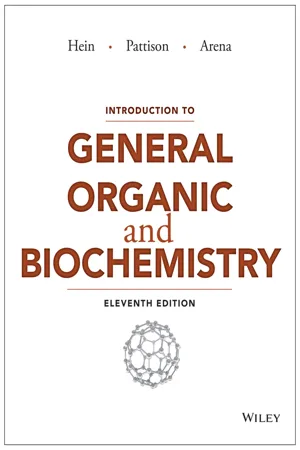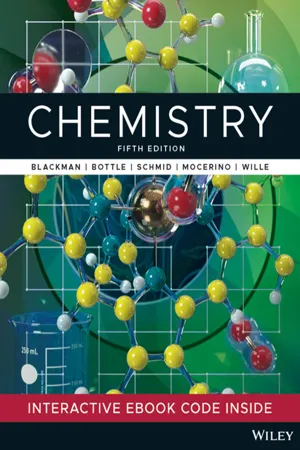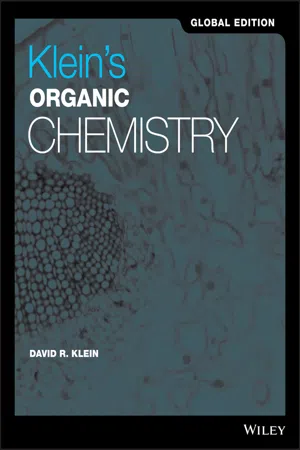Chemistry
Basicity of Alcohols
The basicity of alcohols refers to their ability to donate a pair of electrons to a proton. Alcohols are considered weak bases due to the presence of the hydroxyl group, which can accept a proton to form an oxonium ion. The basicity of alcohols can be influenced by factors such as the nature of the alcohol and the solvent environment.
Written by Perlego with AI-assistance
Related key terms
1 of 5
5 Key excerpts on "Basicity of Alcohols"
- Morris Hein, Scott Pattison, Susan Arena, Leo R. Best(Authors)
- 2014(Publication Date)
- Wiley(Publisher)
22.4 CHEMICAL PROPERTIES OF ALCOHOLS Write equations to illustrate the typical reactions of alcohols. An alcohol contains the hydroxyl functional group ( i OH). Chemists have chosen the term functional group to indicate that this group brings a “function” to an organic molecule. Just as adding new electronic chips to a calculator adds new functions, attaching a hydroxyl group to an alkyl chain allows a molecule to function in new ways. As we have seen, the i OH group interacts with water so that when a molecule adds a hydroxyl group, its solubility in water increases. In general, the “functions” of a hydroxyl group help determine the properties of an alcohol. Acidic and Basic Properties Aliphatic alcohols are similar to water in their acidic/basic properties. If an alcohol is mixed with a strong acid, it will accept a proton (act as a Brønsted–Lowry base) to form a protonated alcohol or oxonium ion: CH 3 OH � H 2 SO 4 CH 3 O � H H � HSO 4 � Alcohols also can act as Brønsted–Lowry acids. Methanol and ethanol have approximately the same acid strength as water, while the larger alcohols are weaker acids than water, reflecting the properties of the longer alkanelike carbon chains. Both water and alcohols react with alkali metals to release hydrogen gas and an anion: sodium hydroxide H 2 O � 2 Na 2 Na � 2 � OH � H 2 sodium ethoxide CH 3 CH 2 OH � 2 Na 2 Na � 2 � OCH 2 CH 3 � H 2 (g) (g) KEY TERMS oxonium ion alkoxide ion Saytzeff’s rule condensation reaction LEARNING OBJECTIVE 22.4 • Chemical Properties of Alcohols 545 The resulting anion in the alcohol reaction is known as an alkoxide ion (RO - ). Alkoxides are strong bases (stronger than hydroxide), and so they are used in organic chemistry when a strong base is required in a nonaqueous solution. The order of reactivity of alcohols with sodium or potassium is primary 7 secondary 7 tertiary. Alcohols do not react with sodium as vigorously as water.- eBook - PDF
- David R. Klein(Author)
- 2021(Publication Date)
- Wiley(Publisher)
12.2 Acidity of Alcohols and Phenols 535 12.2 Acidity of Alcohols and Phenols Acidity of the Hydroxyl Functional Group As we learned in Chapter 3, the acidity of a compound can be qualitatively evaluated by analyzing the stability of its conjugate base: ...deprotonate... –H + To evaluate the acidity of this compound... R H O ...and assess the stability of the conjugate base (an alkoxide ion) R O - The conjugate base of an alcohol is called an alkoxide ion, and it exhibits a negative charge on an oxygen atom. A negative charge on an oxygen atom is more stable than a negative charge on a car- bon or nitrogen atom but less stable than a negative charge on a halogen, X (Figure 12.2). Increasing stability Most stable X R O R H N Least stable R - - - - Therefore, alcohols are more acidic than amines and alkanes but less acidic than hydrogen halides (Figure 12.3). The pK a for most alcohols falls in the range of 15–18. R H pK a between 45 and 50 Increasing acidity pK a between 35 and 40 R NH 2 pK a between 15 and 18 R OH pK a between – 10 and 3 H X Reagents for Deprotonating an Alcohol There are two common ways to deprotonate an alcohol, forming an alkoxide ion. 1. A strong base can be used to deprotonate the alcohol. A commonly used base is sodium hydride (NaH), because hydride (H − ) deprotonates the alcohol to generate hydrogen gas, which bub- bles out of solution: Hydrogen gas H 2 Ethanol H O Sodium hydride Na H Sodium ethoxide Na O + + − + − + 2. Alternatively, an alcohol can be deprotonated upon treatment with Li, Na, or K. These metals react with the alcohol to liberate hydrogen gas, producing the alkoxide ion. O H Na O Na + H 2 1 2 − + LOOKING BACK The factors affecting the stability of a negative charge were first discussed in Section 3.4. LOOKING BACK Recall that a strong acid will have a low pK a value. To review the relationship between pK a and acidity, see SkillBuilder 3.2. FIGURE 12.2 The relative stability of various anions. - eBook - PDF
- Allan Blackman, Steven E. Bottle, Siegbert Schmid, Mauro Mocerino, Uta Wille(Authors)
- 2022(Publication Date)
- Wiley(Publisher)
Basicity of Alcohols In the presence of a strong acid, the oxygen atom of an alcohol is a weak base and reacts with the acid by proton transfer to form an oxonium ion. The reaction in which ethanol is acting as a base and the hydronium ion is acting as an acid is also an example of a simple acid–base reaction. hydronium ion (pK a = –1.7) ethyloxonium ion (pK a = –2.4) ethanol CH 3 CH 2 O H + H O H CH 3 CH 2 H + O H + H H O + H Thus, depending on conditions, alcohols can function as either weak acids or weak bases. Reaction with active metals FIGURE 19.7 Methanol reacts with sodium metal to produce hydrogen gas. Like water, alcohols react with Li, Na, K, Mg and other active metals to liberate hydrogen gas. However, in the case of alcohols, metal alkoxides rather than hydroxides are formed. In the following oxidation–reduction reaction, Na is oxidised to Na + and H + is reduced to H 2 (figure 19.7). 2CH 3 OH + 2Na → 2CH 3 O − Na + sodium methoxide + H 2 The name of an alkoxide ion is derived from a prefix showing the number of carbon atoms and their arrangement (e.g. meth-, eth-, isoprop-, tert-but-) followed by the suffix -oxide. Alkoxides can also be named as alkanolates by adding the suffix -ate to the alcohol name (e.g. methanolate, ethanolate). Alkoxide ions are generally stronger bases than the hydroxide ion. In addition to sodium methoxide, the following metal salts of alcohols are commonly used in organic reactions that require a strong base in a Pdf_Folio:959 CHAPTER 19 Alcohols, amines and related compounds 959 nonaqueous solvent: sodium ethoxide in ethanol, and potassium tert-butoxide in 2-methylpropan-2-ol (tert-butyl alcohol). sodium ethoxide potassium tert-butoxide O – K + O – Na + As we saw in the chapter on haloalkanes, alkoxide ions can also be used as nucleophiles in substitution reactions. Conversion to haloalkanes The conversion of an alcohol to a haloalkane involves substituting a halogen for the OH group at a saturated carbon atom. - eBook - PDF
- David R. Klein(Author)
- 2020(Publication Date)
- Wiley(Publisher)
These metals react with the alcohol to liberate hydrogen gas, producing the alkoxide ion. O H Na O Na + H 2 1 2 ⊝ ⊕ LOOKING BACK Recall that a strong acid will have a low pK a value. To review the relationship between pK a and acidity, see SkillBuilder 3.2. FIGURE 13.2 The relative stability of various anions. FIGURE 13.3 The relative acidity of alkanes, amines, alcohols, and hydrogen halides. Conceptual CHECKPOINT 13.4 Draw the alkoxide ion that is formed in each of the following cases: (a) OH Na ? (b) OH NaH ? (c) OH Li ? (d) OH NaH ? Factors Affecting the Acidity of Alcohols and Phenols How can we predict which, of a number of alcohols, is more acidic? In this section, we will explore three factors for comparing the acidity of alcohols. 1. Resonance. One of the most significant factors affecting the acidity of alcohols is resonance. As a striking example, compare the pK a values of cyclohexanol and phenol: OH Cyclohexanol (pK a = 18) OH Phenol (pK a = 10) 558 CHAPTER 13 Alcohols and Phenols When phenol is deprotonated, the conjugate base is stabilized by resonance. O O O O O ⊝ ⊝ ⊝ ⊝ ⊝ This resonance-stabilized anion is called a phenolate, or phenoxide, ion. Resonance stabilization of the phenoxide ion explains why phenol is eight orders of magnitude (100,000,000 times) more acidic than cyclohexanol. As a result, phenol does not need to be deprotonated with a very strong base like sodium hydride. Instead, it can be deprotonated by hydroxide. H 2 O H O + + Na OH O Na (pK a = 10) (pK a = 15.7) ⊝ ⊝ ⊕ ⊕ The acidity of phenols is one of the ways in which phenols differ from alcohols. Later in this chapter and again in Chapter 19, we will see other reasons why phenols belong to a class of their own. 2. Induction. Another factor in comparing the acidity of alcohols is induction. As an example, compare the pK a values of ethanol and trichloroethanol. - eBook - ePub
Understanding Advanced Organic and Analytical Chemistry
The Learner's ApproachRevised Edition
- Kim Seng Chan, Jeanne Tan;;;(Authors)
- 2016(Publication Date)
- WS EDUCATION(Publisher)
3 – group, the benzene ring is more electron-rich. As a result of the electron-rich benzene ring, the highly electronegative O atom has an “alternative” source of electrons to distort from rather than to just distort it from the H atom. Thus, the electron-deficiency of the H atom is much lower than that of phenol. This would make the H atom of 4-methylphenol less susceptible to extraction by a base, hence less acidic. As for 4-bromophenol, the reverse is true. The less electron-rich benzene ring would make the highly electronegative O atom “bully” the H atom more than that in phenol. The higher electron deficiency of the H atom of 4-bromophenol would then be more acidic in nature. Therefore, note that although we have been constantly using the stability of the conjugate base to account for the acidity, the reality is that the strength of the acidity actually lies on the level of electron deficiency in the H atom.Q:How then do you explain the acidic trend using the electron deficiency of the H atom?A:It is not difficult. Alcohol is less acidic than water because the electron-donating alkyl group intensifies the electron density on the O atom, making it less polarizing, thus resulting in a smaller degree of electron deficiency on the H atom. Phenol is more acidic than water because the lone pair of electrons on the O atom can delocalize into the benzene ring; this makes the O atom more polarizing than the O atom of water, which means greater electron deficiency on the H atom of phenol. As for carboxylic acid, the lone pair of electrons on the O atom of the –OH group can delocalize onto another highly electronegative O atom. This causes the O atom of the –OH group to be more polarizing as compared to phenol, thus making carboxylic acid a stronger acid than phenol.We have seen how the nature of a substituent affects the stability of carbocations (see Chapter 5 on Alkenes and Chapter 6 on Arenes). Likewise, the nature of a substituent can also affects the stability of the anions but in the reverse order. Take, for instance, the same substituents, the ethyl group and the Br atom, found on a carbocation and an alkoxide ion:• The electron-donating ethyl group stabilizes the carbocation by dispersing the positive charge on it. On the other hand, the ethyl group destabilizes the alkoxide ion by intensifying the negative charge on the O atom.As a result of this, we would expect a tertiary alcohol to be less acidic than a secondary alcohol, which would in turn be less acidic than a primary alcohol — the more alkyl groups that are present, the greater would be the intensification of electron density on the O atom, thus the greater the destabilization of the conjugate base.
Index pages curate the most relevant extracts from our library of academic textbooks. They’ve been created using an in-house natural language model (NLM), each adding context and meaning to key research topics.




